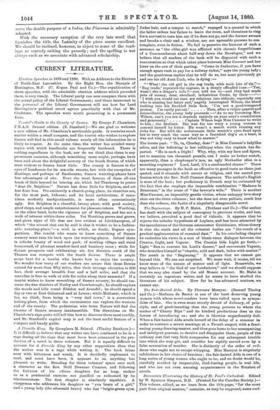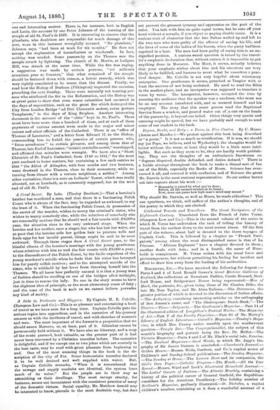owl and interesting matter. There is, for instance, both in
English and Latin, the account by one Peter Johnson of the burning of the steeple of old St. Paul's in 1561. It is interesting to observe that the plumbers, who doubtless are responsible for much damage of this sort, were in this instance wrongfully accused. "No plumbers," Johnson says, " had been at work for six months." He does not accept the explanation of incendiarism or witchcraft. In fact, nothing was needed. Some passers-by on the Thames saw the steeple struck by lightning. The church of St. Martin, at Ludgate Hill, was struck at the same time. While the fire was raging, a suggestion was made by certain persons, "rei militaris scientiam prae se ferentes," that what remained of the steeple should be battered down with cannon, a heroic remedy, which was very rightly considered to be worse than the disease. Finally, we read how the Bishop of Durham (Pilkiogton) improved the occasion, preaching the next Sunday. There were naturally not wanting per- sons who attributed the fire to the Reformation, and the Bishop was at great pains to show that even worse calamities had occurred in the days of superstition, such as the great fire which destroyed the City from London Bridge " ad Divi Clementis aedem, extra portam Templarem," in the days of King Stephen. Another interesting document is the account of the "obits" kept in St. Paul's. There must have been more than a hundred of them, and at each of them payments of various amount were made to the major and minor canons and other officials of the Cathedral. There is an "office of Thomas of Lancaster," and a letter from Edward II. to the Bishop, commanding him to forbid the practice of certain persons who, "fatue accedentes " to certain pictures, and among them that of Thomas, late Earl of Lancaster, " inimici et rebellis nostri," worshipped, and affirmed that miracles were wrought. We have also a "Short Chronicle of St. Paul's Cathedral, from 1140 to 1341," for the most part confined to home matters, but containing a few such entries as that " the Abbot of Abingdon, with four monks and two boatmen, were drowned in the Thames, close to their monastery, while re- turning from dinner with a certain neighbour, a soldier." Among other curiosities, there is a note on Lollards' Tower, which was really situated, not at Lambeth, as is commonly supposed, but at the west end of old St. Paul's.































 Previous page
Previous page